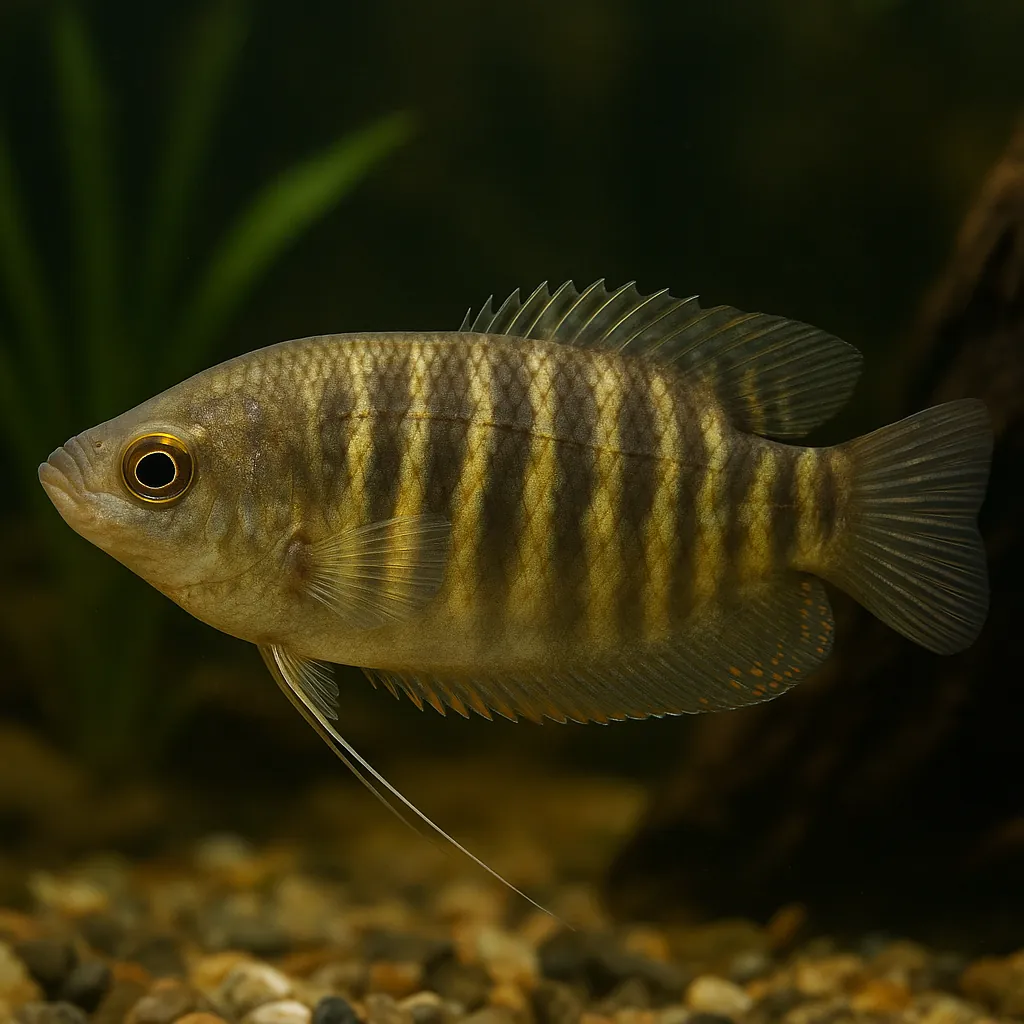
Banded gourami
Introduction
The Banded Gourami (Trichogaster fasciata), also known as the Striped Gourami, is a captivating freshwater fish cherished by aquarists for its vibrant coloration and peaceful demeanor. Native to South and Southeast Asia, this species is well-suited for community aquariums, making it an excellent choice for both novice and intermediate fishkeepers. With proper care, Banded Gouramis can thrive and display their full beauty in a home aquarium.
Care and Environment
Providing the right environment is crucial for the health and well-being of Banded Gouramis. Here's a comprehensive guide to their care:
What is the minimum tank size for a Banded Gourami?
A minimum tank size of 70 liters is recommended for a pair of Banded Gouramis. This space allows them to swim freely and establish territories without stress.
What are the ideal water parameters for Banded Gouramis?
Maintain a temperature between 22°C and 28°C, a pH range of 6.0 to 7.5, and water hardness between 4 to 15 dGH. Consistent water quality is essential to prevent stress and disease.
How should the tank be set up for Banded Gouramis?
Use a dark substrate to enhance their coloration and provide ample hiding spots with plants, driftwood, and floating vegetation. Ensure the tank has a secure lid, as Banded Gouramis are known to jump.
What is the recommended diet for Banded Gouramis?
They are omnivorous and thrive on a varied diet, including high-quality flakes, pellets, and live or frozen foods like bloodworms and brine shrimp. Regular feeding enhances their health and coloration.
Are there any specific challenges in keeping Banded Gouramis?
They are generally hardy but can be sensitive to sudden changes in water parameters. During breeding, males may become territorial, so monitoring their behavior is important.
Origin and Habitat
Banded Gouramis are indigenous to regions in South and Southeast Asia, including India, Bangladesh, Nepal, and Myanmar. They inhabit slow-moving or stagnant waters such as rivers, ponds, lakes, and rice fields, often preferring areas with dense vegetation and minimal current. These environments provide ample hiding spots and breeding grounds, which are essential for their survival.
What type of water bodies do Banded Gouramis naturally inhabit?
They are commonly found in slow-moving rivers, ponds, lakes, and rice fields with dense vegetation and minimal current.
How does their natural habitat influence their care in aquariums?
Replicating their natural environment with plenty of plants and calm waters helps them feel secure and exhibit natural behaviors.
Temperament and Compatibility
Banded Gouramis are known for their peaceful and shy nature, making them suitable for community tanks. However, males can become territorial during breeding seasons.
Are Banded Gouramis aggressive?
They are generally peaceful but may display aggression during spawning. Providing ample space and hiding spots can mitigate this behavior.
What are suitable tank mates for Banded Gouramis?
Compatible tank mates include rasboras, danios, barbs, loaches, and smaller catfish. Avoid housing them with aggressive species or those that may nip at their fins.
Can Banded Gouramis be kept with other gourami species?
They can coexist with other gouramis in larger tanks, but avoid pairing them with Thick-lipped Gouramis (Colisa labiosa) to prevent hybridization.
Interesting Facts
Banded Gouramis possess a labyrinth organ, allowing them to breathe atmospheric air, enabling survival in oxygen-poor waters. Males construct bubble nests during breeding, showcasing intricate parental care. Their vibrant colors and patterns can vary based on geographical location, adding to their appeal among aquarists.
What is unique about the Banded Gourami's breathing mechanism?
They have a labyrinth organ that allows them to breathe atmospheric air, enabling survival in low-oxygen environments.
How do Banded Gouramis reproduce?
Males build bubble nests at the water's surface to protect eggs and fry, displaying remarkable parental care.
Do Banded Gouramis exhibit color variations?
Yes, their coloration can vary depending on their geographical location, with some populations displaying different hues and patterns.
Sources
All information in this article has been gathered from the following reputable sources:
Overview
Recommended Tank Size 26.4 Gallons (for a pair) |
Minimum Group Size 2 |
Minimum Tank Volume 18.5 Gallons |
Maximum Adult Length 4.9 inches |
Average Adult Length 3.9 inches |
Shoaling (6+ required) No |
Preferred Water Type Freshwater, soft to moderately hard, slightly acidic to neutral |
Temperature Range (°C) 22–28 |
pH Range 6.0–7.5 |
Water Hardness (dGH) 4–15 |
Typical Lifespan (years) 4 years |